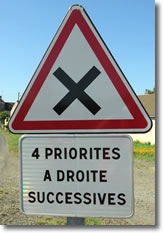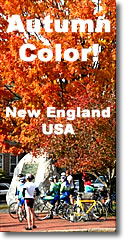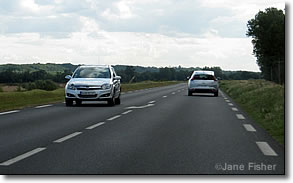 |
Driving a Car in France | |
| Driving a car in France can be a delight, but may be quite different from what you're used to at home. | ||
|
|
|
If you are accustomed to driving a car mostly on wide, fast, limited-access divided highways, you will have a different experience in France. French HighwaysYes, France has fine autoroutes (expressways, motorways) that are useful for longer intercity or cross-country journeys, but much of the joy of driving in France comes on its two-lane Routes Nationales and narrow backroads. Many times these two-lane Nationale (N) and Départementale (D; regional) roads provide the shortest and fastest route between points, but you should be cautious using your GPS system: it may take you on the shortest route, a winding country road where local traffic may go at unsafe speeds. More... Besides the standard European traffic signs, there are numerous additional directional and cautionary signs, most only in French. Most French drivers obey traffic regulations, including speed limits. Some follow too closely (tailgating). Radar is used to control vehicle speed in some places. You may or may not be warned that radar is in use. You may simply find a speeding fine added to your rental car account. Vehicle PriorityRules for which vehicle takes priority in certain situations are elaborate and important in France, and you must understand and observe them. More... MotorcyclesThe big danger is from motorbikes and motorcycles which drive carelessly and often dangerously, weaving among speeding vehicles on highways, and speeding through the gaps between lines of cars slowed in traffic jams. The motorcyclists rely on you and every other auto driver to do what they expect you to do in order to keep them (the motorcyclists) from being maimed or killed in an accident of their creation. BicyclesBicycles are popular for transportation, sport and touring in France, and have been for more than a century. Cyclists have the same rights on the road as motor vehicles, and must follow all traffic regulations, just like cars. More... You must share the road with cyclists on streets in cities and towns, and on two-lane Nationale highways, accommodating them as you would any other vehicle. Cyclists riding in a group should ride single file along the right edge of the road, leaving gaps between cyclists so that cars passing/overtaking can move back in line when a vehicle approaches from the opposite direction. At corners, cycists should signal any turns. They have priorityif they are in front of you. In roundabouts/ traffic circles (rond-point), cyclists may enter when traffic permits, and should signal their intentions as they move through the circle. If there is a cyclist in front of you, do not pass, but follow as you would any other vehicle. More... Buses & TrucksMost heavy vehicle drivers are competent professionals who want no trouble, drive safely, and put up with amazing abuse at the hands of auto drivers and motorcyclists. PedestriansPedestrians have the right of way at crosswalks if a traffic signal is not present, and must be given priority. This law is commonly observed by all drivers, including bicyclists. In Towns & VillagesIn towns and villages, the traditional streets vary in width. Even the main street through town may be too narrow for two vehicles to pass. Signs may indicate which direction has priority. You may have to stop and wait for oncoming traffic to clear before you can proceed. A truck parked temporarily to unload goods may block traffic for some minutes. On market days, portions of main streets may be closed to traffic, requiring you to find other routes.
|
|
Above, typical 2-lane Route
Nationale
|




